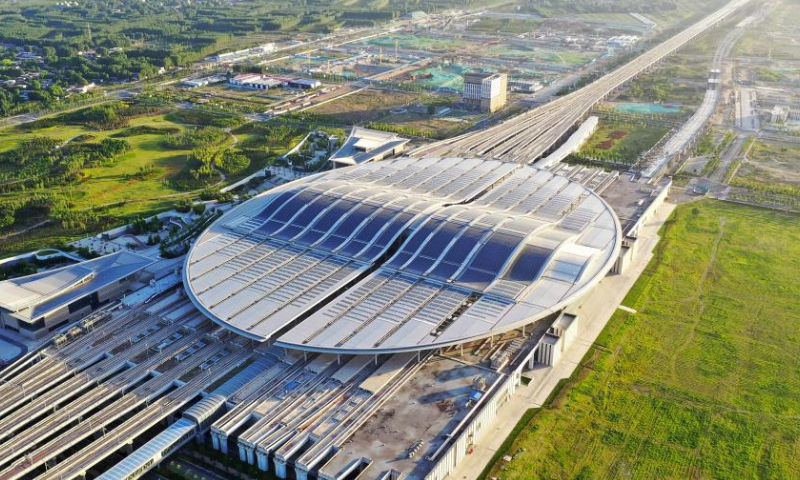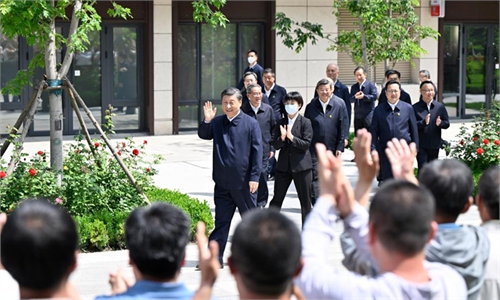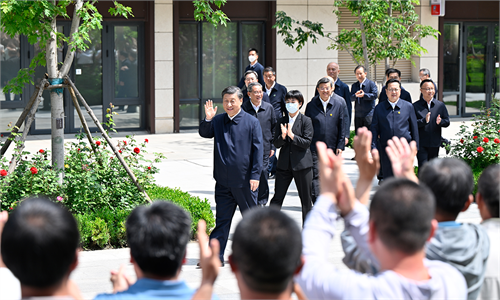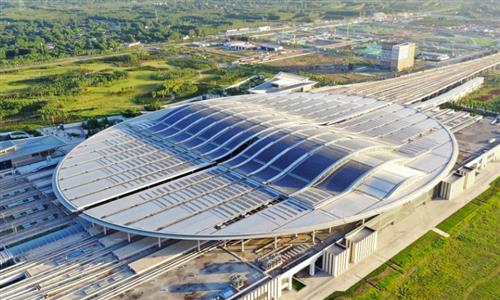
This aerial photo taken on June 2, 2023 shows the Xiong'an Railway Station in Xiong'an New Area, north China's Hebei Province. Located about 100 kilometers southwest of Beijing, the Xiong'an New Area has been designed as a major recipient of functions previously located in Beijing but which are not essential to its role as China's capital. Six years on, Xiong'an New Area, China's "city of the future", is offering a glimpse of the Chinese vision of modernity. (Xinhua/Zhu Xudong)
As one of the agenda items for Vietnamese Prime Minister Pham Minh Chinh's trip to China, he visited Xiong'an New Area in North China's Hebei Province on Wednesday and vowed to learn the planning and construction experience of the area, according to media reports.
Pham visited one of the construction areas, an integrated service center, the Xiong'an intercity railway station and other projects, learning about the construction and development of the area at length, local newspaper Shijiazhuang Daily reported on Thursday.
The planning and construction of the Xiong'an New Area has achieved important periodical results, and a "city of future" has taken shape, which Vietnam deeply admires, Pham was quoted as saying.
The successful construction not only benefits Hebei residents and Chinese people, it also offers valuable experience for Vietnam, Pham said, stressing that Vietnam will continuously deepen exchanges with all parts of China including Hebei Province, earnestly learn from the experience of planning and construction of the Xiong'an New Area, strengthen cooperation in such fields as economy, trade, tourism, education and culture, and to promote mutual benefit and win-win cooperation.
Vietnam's capital city Hanoi, after years of rapid development, has seen its city construction lag behind the demand for expansion. And Xiong'an, as a city designed to meet future growth, offers a great reference for city construction of Hanoi, Zhou Shixin, director of the Institute for Foreign Policy Studies at the Shanghai Institute for International Studies, told the Global Times on Thursday.
In April 2017, China announced to establish the Xiong'an New Area, located about 100 kilometers southwest of Beijing, as part of measures to advance the coordinated development of the Beijing-Tianjin-Hebei region. It will see the transfer of functions from Beijing that are not related to the capital, explore a new model of optimized development in densely populated areas, according to Xinhua News Agency.
Dubbed as the "city of future," Xiong'an has adopted high standards since the beginning of its construction. A twin digital city has been under construction as well, and a 153-kilometer digital road has been put into use in the city's Rongdong bloc which will further extend to 500 kilometers covering the whole area.
Pham arrived in China on Sunday and started his four-day visit of the country. This year marks the 15th anniversary of the establishment of China-Vietnam comprehensive strategic cooperative partnership, and the two have vowed to deepen cooperation in various areas. China has vowed to import more from Vietnam and Vietnam stressed to continue to actively participate in the promotion of China-proposed Belt and Road Initiative.
The two Asian countries enjoy huge cooperative potential from agricultural trading to infrastructure construction, such as railways, Zhou said.
While the Western countries have seen weakened demand amid the sluggish global economy, strengthening cooperation with China is of great significance for Vietnam's growth as China has been a major raw material provider as well as a key market for the Southeast Asian country.
In the meantime, Vietnam has been China's largest trading partner within the Association of Southeast Asian Nations bloc. In 2022, bilateral trade recorded $175.6 billion, accounting for about 24 percent of Vietnam's foreign trade, media reports said, citing Vietnam's official data.
Global Times



